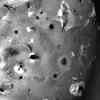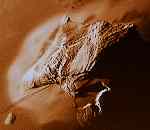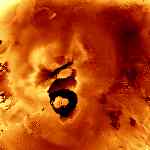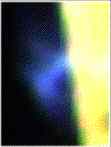Jupiter I
Io ( “EYE oh” ) is the fifth of Jupiter’s known satellites and the third largest; it is the innermost of the Galilean moons. Io is slightly larger than Earth’s Moon.
orbit: 422,000 km from Jupiter
diameter: 3630 km
mass: 8.93e22 kg
The pronunciation “EE oh” is also acceptable.
Jupiter’s moon Io is the most active volcanic natural satellite in our Solar System. The lava which erupts from its active volcanoes can travel up to 10 miles high (or kilometres). The moon is named after Io in Greek mythology, a woman who turned into a cow during a dispute between Zeus and Hera.
When was Io discovered?
Io was discovered with three other moons (Europa, Ganymede and Callisto) in 1610 by Galileo Galilei. The discovery of the Jovian moons led to the understanding that the planets in our Solar System orbit the Sun, rather than the Universe orbiting the Earth.
When Galileo first discovered the moons of Jupiter he called them the Medicean planets, after a powerful Italian Medici family. He also referred to the moons numerically as I, II, III, and IV. This system was used until the mid-1800s when the satellites were given their mythological names. It was decided this would be best as the numerical system would become very confusing as new moons were being discovered.
How did Io get its name?
The innermost moon of Jupiter got its name from a mortal woman in Greek mythology who got turned into a cow when Zeus and Hera, King and Queen of the gods, had a marital spat.
Before it was named Io, Galileo named the moon Jupiter I.
Orbit Facts
- Io is Jupiter’s innermost of Galileon moons and is the fifth natural satellite out from Jupiter.
- Io orbits 421,700 km from Jupiter’s centre.
- Io orbits Jupiter in 42.5 hours.
- Io orbits Jupiter twice for every one orbit of Europa and four orbits to every one orbit Ganymede completes.
- Both Europa and Ganymede exert periodic gravitational influence on Io, this is known as orbital resonance.
- The orbital resonance and the tidal forces from Jupiter are the primary heat source of Io’s volcanic activity.
- Io rotates around Jupiter synchronously, keeping one hemisphere pointing toward Jupiter (leading hemisphere) and the other pointing away (trailing hemisphere).
Related: – Which planet has the most moons?
Geological Facts
- Io has over 400 active volcanoes on the surface of the small moon. This makes the satellite the most actively volcanic object in our Solar System.
- Io’s volcanoes produce plumes of sulphur and sulphur oxide which can reach 500 km above the surface of the moon.
- The volcanic activity of Io has shaped a lot of its geological features.
- The lava flows and volcanic plums have created massive surface changes.
- Io’s surface is covered in lava flows which can be as long as 500 km (300 miles).
- Io also has over 100 mountains, and some of them are larger than Mount Everest.
- Io is made from silicate rock which surrounds an iron-sulfide core.
- Io’s surface is primarily yellow because it is covered in sulphur and sulphur-dioxide frost. The frost is created due to atmospheric volcanic gases freezing and falling to the surface.
Expeditions to Io Facts
- In 1973 Pioneer 10, and its sister mission Pioneer 11 (1974), both take close up measurements of Io.
- Voyager 1 takes data of Io on a flyby of the moon in March 1979.
- Voyager 2 takes further snapshots of Io in July 1979 at a greater distance upon its flyby.
- From 1992 to 2002 the Galileo spacecraft takes the closest images and data captures of Io of any space mission.
- In 20o0 the Cassini spacecraft takes snapshots of Io on its way to Saturn.
- In 2007 the New Horizon mission took further snapshots of Io as it fly by and its way to to the outer edges of our Solar System.
Io was a maiden who was loved by Zeus (Jupiter) and transformed into a heifer in a vain attempt to hide her from the jealous Hera.
Discovered by Galileo and Marius in 1610.
In contrast to most of the moons in the outer solar system, Io and Europa may be somewhat similar in bulk composition to the terrestrial planets, primarily composed of molten silicate rock. Recent data from Galileo indicates that Io has a core of iron (perhaps mixed with iron sulfide) with a radius of at least 900 km.

Io’s surface is radically different from any other body in the solar system. It came as a very big surprise to the Voyager scientists on the first encounter. They had expected to see impact craters like those on the other terrestrial bodies and from their number per unit area to estimate the age of Io’s surface. But there are very few, if any, impact craters on Io (left). Therefore, the surface is very young.
Instead of craters, Voyager 1 found hundreds of volcanic calderas. Some of the volcanoes are active! Striking photos of actual eruptions with plumes 300 km high were sent back by both Voyagers (right) and by Galileo (bottom left image on this page) This may have been the most important single discovery of the Voyager missions; it was the first real proof that the interiors of other “terrestrial” bodies are actually hot and active. The material erupting from Io’s vents appears to be some form of sulfur or sulfur dioxide. The volcanic eruptions change rapidly. In just four months between the arrivals of Voyager 1 and Voyager 2 some of them stopped and others started up. The deposits surrounding the vents also changed visibly.

Recent images taken with NASA’s Infrared Telescope Facility on Mauna Kea, Hawaii show a new and very large eruption (right). A large new feature near Ra Patera has also been seen by HST. Images from Galileo also show many changes from the time of Voyager’s encounter. These observations confirm that Io’s surface is very active indeed.

Io has an amazing variety of terrains: calderas up to several kilometers deep, lakes of molten sulfur (below right), mountains which are apparently NOT volcanoes (left), extensive flows hundreds of kilometers long of some low viscosity fluid (some form of sulfur?), and volcanic vents. Sulfur and its compounds take on a wide range of colors which are responsible for Io’s variegated appearance.
Analysis of the Voyager images led scientists to believe that the lava flows on Io’s surface were composed mostly of various compounds of molten sulfur. However, subsequent ground-based infra-red studies indicate that they are too hot for liquid sulfur. One current idea is that Io’s lavas are molten silicate rock. Recent HST observations indicate that the material may be rich in sodium. Or there may be a variety of different materials in different locations.

Some of the hottest spots on Io may reach temperatures as high as 2000 K though the average is much lower, about 130 K. These hot spots are the principal mechanism by which Io loses its heat.
The energy for all this activity probably derives from tidal interactions between Io, Europa, Ganymede and Jupiter. These three moons are locked into resonant orbits such that Io orbits twice for each orbit of Europa which in turn orbits twice for each orbit of Ganymede. Though Io, like Earth’s Moon always faces the same side toward its planet, the effects of Europa and Ganymede cause it to wobble a bit. This wobbling stretches and bends Io by as much as 100 meters (a 100 meter tide!) and generates heat the same way a coat hanger heats up when bent back and forth. (Lacking another body to perturb it, the Moon is not heated by Earth in this way.)

Io also cuts across Jupiter’s magnetic field lines, generating an electric current. Though small compared to the tidal heating, this current may carry more than 1 trillion watts. It also strips some material away from Io which forms a torus of intense radiation around Jupiter. Particles escaping from this torus are partially responsible for Jupiter’s unusually large magnetosphere.
Recent data from Galileo indicate that Io may have its own magnetic field as does Ganymede.
Io has a thin atmosphere composed of sulfur dioxide and perhaps some other gases.
Unlike the other Galilean satellites, Io has little or no water. This is probably because Jupiter was hot enough early in the evolution of the solar system to drive off the volatile elements in the vicinity of Io but not so hot to do so farther out.
More about Io
- more images
- Io from Satellites of the Outer Planets
- from JPL
- Io and Luna, a comparison from LANL
- new features seen by HST
- Galileo press release about Io’s core and potential magnetic field
- Fact sheet from the Galileo mission pages
- volcanic plume from volcano Prometheus, from Phil Plait’s excellent Bitsize Astronomy site
- Ionian Web
Open Issues
- It seems that Io is radiating heat faster than the tidal mechanism can generate it. Is the present epoch atypically active? Or is there some additional source of heat?
- What mechanism drives the volcanoes? What is the eruptive material?
- Does Io have its own magnetic field? If so, what is its origin?
